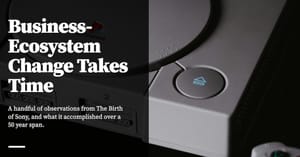This is part 6 of the Principles Sequence, a series on the Ray Dalio book. Read the overall book summary here.
Two years ago, when my company was moving to a new office in the downtown core of Ho Chi Minh City, I made it a point to delegate all renovation decisions to the designer of our team. Actually, I went a step further than that: I gave him a set budget but full autonomy. I didn't even ask him to come to me for opinions; my trust in him was complete.
I made my decision on the back of my familiarity with my team. The rest of the office consisted of software engineers, and I couldn't imagine them designing a physical space with any competence, no more than I could imagine a figure skating cat competing in the Winter Olympics. I'd wager that most of us have made such decisions in the past. “Let Jack do the negotiating, he's good at that sort of thing.” Or “Let Jane handle the publication schedule, she's a lot more organised than most of us.”
The fact is, if you've ever worked long term in a project team, you're probably already familiar with the idea of task-personality-suitability. This is a rather complicated way of saying “assigning tasks to people who have the right disposition for them.” For instance, certain people are more detail oriented than others, and it's probably better to give tasks like planning a wedding to them. Ditto for other kinds of tasks requiring creativity, problem-solving, or selling.
This ability to assign different tasks to different people hinge on understanding their base dispositions. In a group of friends or in a family, this comes naturally, as you're dealing with people you know well. But as a manager, you build this understanding up over time, as you grow to learn the team you've been assigned to.
So here's the question: what happens when you want to scale this practice to a thousand people? What do you do then?
The Conventional Solution
The common answer to this question of scaling managerial judgment is to have good management training. In the ideal conventional organisation, the managers who lead teams are competent, and are trained to assign tasks according to an understanding of individual strengths. This starts at the CEO level and recurses down to every manager below.
But there are problems with this approach, as we are all likely familiar with. Managers aren't uniformly good; there are blind spots in any sufficiently large organisation; one weak link in the hierarchy exposes the organisation to flaws it can't easily get rid of. We know this. Some of us have experienced it first hand. The scars that come from working in a severely dysfunctional large company can run deep.
Ray Dalio's answer to this question of scaling management is radically different. I'm not sure — at this point — that I can call it different good ... I'm more inclined to think it's just ... different.
His solution to this problem of scaling managerial judgment is to use psychometric testing for everything.
Understanding People
This post is a summary of chapter four of Dalio's Life Principles, and it's an odd chapter to summarise. One reason I'm having trouble with this summary is because Dalio spends a lot of time describing the psychometric testing Bridgewater employs to scale management, and the bits where he does so reads like pseudoscience. There's also a large segment of the chapter dedicated to neuroscience, which — depending on your experience with neuroscience — may or may not be convincing to you.
The broad argument the chapter makes, however, is compelling and simple: that there is power from understanding how humans are wired.
Dalio breaks this principle down to a few smaller principles, which broadly fall into two categories. The first category is how understanding the way our brains work will help you in the pursuit of your goals:
- First, that we are born with innate attributes and dispositions that help us and hurt us depending on their application. This is a reference to our personality attributes, which predisposes us to act and think in certain ways. This gives us strengths and therefore corresponding weaknesses.
- That we are social animals, and are built for meaningful work and meaningful relationships. Dalio quotes popular science books that argue that humans crave social connection, and therefore building a life optimised for meaningful work alongside meaningful people is a need, not a want.
- That we should understand the 'great brain battles' in order to control them in the pursuit of your goals. This principle touches on many of the other things we've seen in previous chapters — the idea of the ‘two yous’, where you have to fight your lower brain in order to achieve better outcomes; the idea that you must not let emotion and pride cloud your thinking; the idea that you should chose your habits well, as habits are the amongst the most powerful mental tools (or barriers!) we have.
- On that last point on habits: Dalio argues that habits are hugely powerful and very important when executing on a plan to chase your goals. One sub-principle of note is that we should train our lower brains with kindness and persistence to build the right habits. The right approach to take, Dalio says, when your lower brain messes up, is to treat it as you would a child who doesn't know any better. Don’t bang yourself up over it; in some real sense your lower brain is like a child — it really doesn't know any better.
- Dalio also quotes existing research that the subconscious can be harnessed for creativity. He recommends periods where you clear your head, in order to let creative thoughts from the subconscious in. But he also warns to analyse these thoughts logically, and to never act on them in impulse.
The principles above are covered to some degree in the previous chapters. The second category of principles, however, is about how understanding the way our brains work helps us with managing and influencing others ... in pursuit of your goals. In other words, the principles in Chapter Four are about understanding your brain in order to manage yourself, and understanding human brains in general in order to orchestrate others.
This is where things get interesting.
Orchestrating Others
I get the feeling that Dalio is greatly influenced by his experience with constructing financial instruments. He calls life a “machine” you can “learn to play”, after all, and there’s a famous video where he calls his understanding of macroeconomics “understanding the economic machine”.
No surprise, then, that he’s applied this “machine” framework to managing people.
Employees at Bridgewater are subjected to four psychometric tests: the Myers-Briggs Type Indicator (MBTI), the Workplace Personality Inventory, the Team Dimensions Profile, and the Stratified Systems Theory. Again, everything is used only in so far that it has proven to be useful for the company; Dalio says they're experimenting with the more scientifically-accepted Big Five test and would include it if the results pan out.
How they use it is interesting. Take the (widely discredited) MBTI test, for instance. The MBTI assessment tests for four qualities:
- Introversion vs Extroversion — whether you get your energy from your internal world (introversion) vs interactions with other people (extroversion)
- Intuiting vs Sensing — whether you are a big picture thinker who cares less for details (intuiting) or if you are a highly details-oriented person (sensing)
- Thinking vs Feeling — whether you make decisions based on logical analysis (thinking) or whether you make decisions based on empathy and interpersonal relations (feeling)
- Judging vs Perceiving — whether you prefer to make and follow plans (judging) vs whether you prefer to take things as they come and react flexibly to reality (perceiving).
The usual way MBTI assessments are used is that they're summed together to create a ‘personality profile’, of which there are 16 types. The descriptions of the personality profile then reads like a horoscope. Take, for instance, my MBTI profile, pulled off a quick Google:
INTJs apply (often ruthlessly) the criterion "Does it work?" to everything from their own research efforts to the prevailing social norms. This in turn produces an unusual independence of mind, freeing the INTJ from the constraints of authority, convention, or sentiment for its own sake ... INTJs are known as the "Systems Builders" of the types, perhaps in part because they possess the unusual trait of combining imagination and reliability. Whatever system an INTJ happens to be working on is for them the equivalent of a moral cause to an INFJ; both perfectionism and disregard for authority come into play. Personal relationships, particularly romantic ones, can be the INTJ's Achilles heel ... This happens in part because many INTJs do not readily grasp the social rituals ... Perhaps the most fundamental problem, however, is that INTJs really want people to make sense.
This describes me rather well, but this may well be the Barnum effect in action! The truth is that the personality profiles aren't particularly useful. So what if I’m “The Mastermind” in the MBTI framework? How is this ever helpful in day-to-day business?
What Bridgewater does differently is that they use each trait to inform clashes during heated debate. For instance, Dalio writes:
Before we had assessments to identify these differences, conversations between ‘Ts’ and 'Fs’ were really frustrating. Now we laugh as we bump up against our differences, because we know what they are and can see them playing out in classic ways.
Bridgewater does create psychological types, but they do so on the basis of the results of all four tests, resulting in “twenty-five to fifty attributes (...) each one coming in varying degrees of strength” like colour tones. These ‘twenty-five to fifty attributes’ are scored and then made available on each member's internal company profile, called a "baseball card".
Some of the tests that Bridgewater uses are good when studying team composition. The Team Dimensions Profile, for instance, sorts people in one of five roles:
- Creators generate new ideas and original concepts.
- Advancers communicate these new ideas and extend them, carrying them forward.
- Refiners challenge ideas. They analyse projects for flaws, then refine them with a focus on objectivity and analysis.
- Executors make sure that things get done. They ensure that important activities are carried out and goals are accomplished.
- Flexors are a combination of all four types — they adapt their styles to fit the team needs, and are able to look at a problem from a variety of perspectives.
A Bridgewater employee's baseball card consists of a grid of dots, each representing a personality attribute. The intensity of the colour of the dot indicates the strength of that trait. Because of this visual design, Bridgewater managers can overlay the baseball cards for all members of a team to get a quick visual indicator of missing strengths. Dalio writes:
For example, with the bond systemization project I mentioned earlier, having this new perspective allowed us to better see the gaps between what we had and what we needed. While Bob was a great intellectual partner to me in understanding the big-picture problem we wanted to solve, he was much weaker at visualizing the process required to get us from where we were to the solution. He also wasn’t surrounding himself with the right people. He tended to want to work with people who were like him, so his main deputy on the project was a great sparring partner for mapping out big ideas on a whiteboard but a lousy one for fleshing out the who, what, and when needed to bring those ideas to life. This deputy tested as a “Flexor,” meaning that he was great at going in whatever direction Bob wanted to but lacked the clear, independent view needed to keep Bob on track.
After a few rounds of not making progress, we used our new tools for understanding people and acted on them, pushing Bob to transition to a new deputy who was especially skilled at navigating the levels between the big-picture ideas and the discrete, smaller projects required to bring them about. Comparing the new deputy’s Baseball Card to the original deputy’s, she excelled in independent and systematic thinking, which were essential for having a clear picture of what to do with Bob’s big ideas. This new deputy brought on other layers of support, including a project manager who was less engaged with the concepts and much more focused on the details of specific tasks and deadlines. When we looked at the new team members’ Baseball Cards, we could quickly see them lighting up in some of the areas around being planful, concrete, and driving things to completion, which were areas of weakness for Bob. With this new team in place, things really started to hum. It was only by looking hard at the complete “Lego set” required to achieve our goal—and then going out and finding the missing pieces—that we were able to do it.
Closing Thoughts
Am I convinced that Dalio's central argument is right? Yes, I am. There is real power that comes from sizing people up accurately. This skill allows you to deploy their strengths in an organisational or team setting — which Dalio points out is a need, not a want, due to the way we've evolved as social creatures. In a group setting, good managers can't be good without some form of this ability.
Am I convinced that Dalio's management style at Bridgewater makes sense? No, I'm not entirely convinced. I believe there are several interesting ideas here — including that of rigorous psychometric testing — that I may want to try out the next time I'm in charge of a team. But I also think Dalio's desire to systematise everything leaves gaping holes in his management practice.
Take, for instance, the research into psychological safety. Research at Google's Project Aristotle and in the academic literature show us that team composition does not matter as much as its level of psych safety — or, to put another way, that group norms override the strengths of the individuals within.
Dalio's solution to guaranteeing that group norms don't override individual strengths is to create a culture of systematised truth-seeking in his entire company. In a conventional organisation, high psych safety ensures group members are able to contribute equally, pooling their strengths together during group decision making. At Bridgewater, psych safety doesn't matter due to its overarching culture of honest, biting criticism, its tough love ethos, its protocol of thoughtful disagreement, and the pressing need of the business to seek the truth at all costs.
The cost, of course, is that Bridgewater's turnover is a third of its new employees. Its culture of rigorous, ruthless truth-seeking has resulted in an experience that Dalio likens to “entering a nudist camp”. Stories abound of employees leaving in tears.
In the end, however, it does not matter what I believe. I'm optimistic that there's a spot somewhere in the organisational solution space that allows one to scale psych safety without creating a ruthless Bridgewater-like culture. But I say this as an observer, not as a practitioner — or at least, not yet. Dalio, on the other hand, has spent his life's work building Bridgewater, and the unique circumstances of its birth, its early employees, and the industry it functions in has allowed him to create a powerfully effective organisational design, one that works for his firm, and one that’s birthed the book I'm reading today.
Next: Part 6 — Being an Effective Decision Maker.
This is part 6 of the Principles Sequence. Subscribe here, or follow the blog on RSS/Twitter.
Originally published , last updated .




